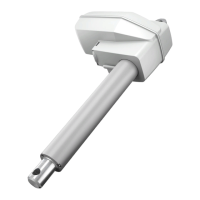Page 65 of 295
Options:
• Mechanical spline: When using the actuator in a vertical position, the force needed to activate the mechanical spline is maximum 60 N + the
weight of the application. To reengage the spline function, a force of maximum 60 N is needed. Same installation dim. as standard actuator.
• A modified Bowden cable holder is available (as a special article), with better cable alignment and improved guidance of the cables.
• Electric spline: When using the actuator in a vertical position, the force needed to activate the electric spline is maximum 100 N + the weight of
the application. To reengage the spline function, a force of maximum 100 N is needed.
Usage
• Duty cycle: 2/18 – 2 minutes continuous use followed by 18 minutes not in use
• Ambient temperature: + 5 °C to + 40 °C
• Compatibility: Compatible with LINAK control boxes. Please contact LINAK
• Approvals: IEC60601-1, ANSI / AAMI ES60601-1 and CAN / CSA-22.2 No 60601-1 for LA34 24V zinc and composite versions.
LA34 is a technological state-of-the-art actuator that, due to its innovative construction
can push up to 10,000 N at a speed of 5 mm/sec. and with a current consumption of
approx. 7 Amp. The strong LA34 actuator is made in a low weight composite material.
Its compact design, the outstanding performance and a wide range of safety options
makes LA34 the right choice for a variety of medical and industrial applications.
The LA34 24V actuator is approved according to IEC 60601-1, ANSI / AAMI ES60601-1,
and CAN / CSA-22.2 No 60601-1.
Reed-switch:
The Reed-switch gives a number of pulses for each rotation of the motor. These pulses are
used to calculate the piston rod’s position as well as to control several actuators running
in parallel.
Your nearest LINAK dealer can inform the number of pulses per stroke length.
Regarding Reed-switch connection, see Figure 6.10.
Recommendations
• Power supply without current cut-off can cause serious damage to the actuator if mechanical stop is encountered or the actuator movement is
blocked in another way.
• LINAK control boxes are designed so that they will short-circuit the motor terminals (poles) of the actuator(s) when the actuator(s) are not running.
This solution gives the actuator(s) a higher self-locking ability. If the actuator(s) are not connected to a LINAK control box the terminals of the motor
must be short-circuited to achieve the self-locking ability of the actuator.
11. LA34 (MEDLINE
®
CARELINE
®
)
Warning
An LA34 actuator is not designed for repeated dynamic push-to-pull movements. This cause extra strain to the actuator and can give safety
considerations, the consequence being possible damage to the actuator. Therefore, if repeated dynamic push-to-pull movements are essential
for the application, perform tests to validate the performance and use a steel piston rod eye (contact LINAK A/S).
LA34 actuators for patient hoists are marked with a label to ensure the user is aware that it is not permitted to handle the patient hoist by
pulling the actuator or otherwise expose it to side forces.
Tests show that uneven running can occur when retracting the LA34 composite actuator with a low load below 500N.
This has no impact on the safety of the actuator and is caused by internal frictions.
If the LA34 actuator is used in connection with a non-LINAK power supply the system must be equipped with current trip cut-off.
Adjustment of the installation dimension N
As standard the installation dimension on the LA34 actuator can be manually adjusted by +4 / -0 mm (not possible for mechanical splines). The
adjustment of the installation dimension must only be made without use of tools only, or hand). It is not allowed to use tools to adjust the installation
dimension of the LA34 actuator as there is a risk that the inner tube may be unscrewed.
Hall
The Hall principle is very similar to the Reed principle. It is a control box, which based on Hall signals, can decide whether the actuator runs out or in.
Hall, however, can detect whether the actuator runs in or out. The number of pulses is like Reed. Hall and Reed are placed opposite the potentiometer
on the actuator’s worm wheel. Therefore, it is not suitable for use in quick release /free wheelingactuators. see figure 10.

